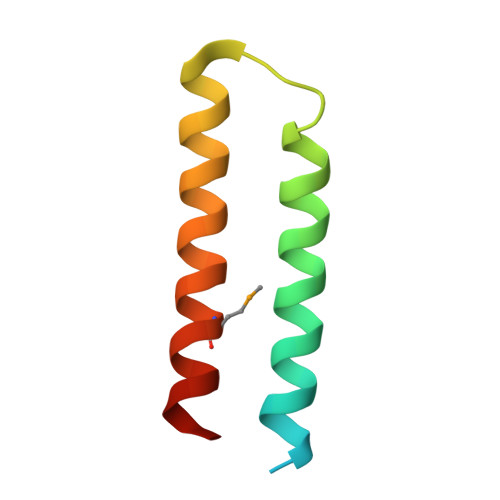Structure of AscE and induced burial regions in AscE and AscG upon formation of the chaperone needle-subunit complex of type III secretion system in Aeromonas hydrophila.
Tan, Y.W., Yu, H.B., Leung, K.Y., Sivaraman, J., Mok, Y.K.(2008) Protein Sci 17: 1748-1760
- PubMed: 18662905
- DOI: https://doi.org/10.1110/ps.036798.108
- Primary Citation of Related Structures:
2Q1K - PubMed Abstract:
In the type III secretion system (T3SS) of Aeromonas hydrophila, the putative needle complex subunit AscF requires both putative chaperones AscE and AscG for formation of a ternary complex to avoid premature assembly. Here we report the crystal structure of AscE at 2.7 A resolution and the mapping of buried regions of AscE, AscG, and AscF in the AscEG and AscEFG complexes using limited protease digestion. The dimeric AscE is comprised of two helix-turn-helix monomers packed in an antiparallel fashion. The N-terminal 13 residues of AscE are buried only upon binding with AscG, but this region is found to be nonessential for the interaction. AscE functions as a monomer and can be coexpressed with AscG or with both AscG and AscF to form soluble complexes. The AscE binding region of AscG in the AscEG complex is identified to be within the N-terminal 61 residues of AscG. The exposed C-terminal substrate-binding region of AscG in the AscEG complex is induced to be buried only upon binding to AscF. However, the N-terminal 52 residues of AscF remain exposed even in the ternary AscEFG complex. On the other hand, the 35-residue C-terminal region of AscF in the complex is resistant to protease digestion in the AscEFG complex. Site-directed mutagenesis showed that two C-terminal hydrophobic residues, Ile83 and Leu84, of AscF are essential for chaperone binding.
- Department of Biological Sciences, National University of Singapore, Singapore 117543.
Organizational Affiliation:

















